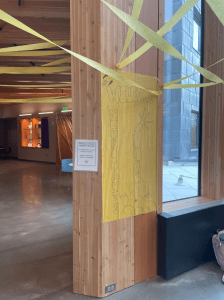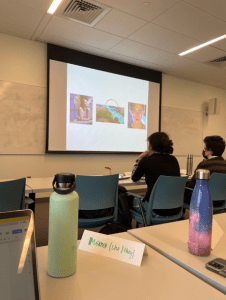Fall: Quantitative Reasoning (QR 140) with 20 people
I took this class because I didn’t pass the quantitative reasoning test. As detailed in our website for QR, “Quantitative reasoning is required in virtually all academic fields, is used in most every profession, and is necessary for decision-making in everyday life. The Quantitative Reasoning Program is designed to ensure that Wellesley College students are proficient in the use of mathematical, logical, and statistical problem-solving tools needed in today’s increasingly quantitative world.”
The class itself wasn’t really hard, and my professor was really approachable with endless office hours, so I’d go to do my homework with him 🙂
QR 140 has a special place in my heart because of my friends. Before coming to Wellesley, I (virtually) met a Wellesley student from Perú. She introduced me to her friend, from Brazil, and before realizing, we created a little community of Latinas: 2 from Perú, 2 from Brazil, and me. QR was the class that my friends from this support system had in common, so I very much looked forward to this class.
Fall: Intro to Bio with 8 People
Because of our shadow grading system (where during our first semester, we don’t have letter grades, only pass/fail grades), I took this biology class to fulfill the lab requirement and to have a strong foundation in science before taking neuroscience. As shown in our course browser, this class is described as, “A foundation course that focuses on the study of life at the cellular and molecular level, including eukaryotic and prokaryotic cell structure, function of biological macromolecules, molecular genetics, cellular metabolism, and key topics in cell biology.”
This class has my whole heart. I find it really special because it was my introduction to natural sciences in college, so it was really important for me to have a good experience. The class went a little too fast for me at times, but we had two instructors that would hold office hours for us. So basically we had office hours almost every day of the week. They loved having us in their office hours; drawing things out to understand complex concepts, etc. Prof. Roden and Prof. Okumura will always be in my heart. If you ever take biology, I’d 100% recommend these profs. The day, and even the same time we had our practicum (final exam for lab), the Argentine soccer team was playing against Croatia to pass through to the final. So my profs would update us on how much time we had left to finish the exam and how the game was going.
The other reason I loved this class was the small size. I could really connect with my peers, to the point that two of the people there became my closest friends (one of them is Sofi, another ASI!). Next fall, Sofi, Bothina and I will room together in Stone D.
Spring: Intro to Neuro with 23 People
I was THRILLED to take this class because I wanted to make sure that I really liked neuroscience. So, I took this class, and I ended up LOVING neuroscience. At first, I didn’t get the big picture, so I found it a little boring as it was really abstract. Then, as the topics got more complex, I got more interested in the brain. I’ve always been drawn to the mind, and neuroscience is the best balance between psychology and biology. Back home, my mom would say lo justo y necesario, which translates to just enough: bio and psych. I like that we learn about the way neurons work: channels opening and closing–that’s not too overwhelming. In the same way, we learn how those channels affect the way we behave!
For a more science-y description of this class, I’ll pull up the original description, “This course will build on basic concepts in neuroscience that were introduced in NEUR 100. Current issues will be examined within a broad framework that includes readings in cellular and molecular, cognitive, behavioral, and computational neuroscience. Topics such as sensory systems, learning, memory, and cognition will be covered. The accompanying laboratory is designed to expose students to basic methods and experimental approaches in neuroscience.”


















